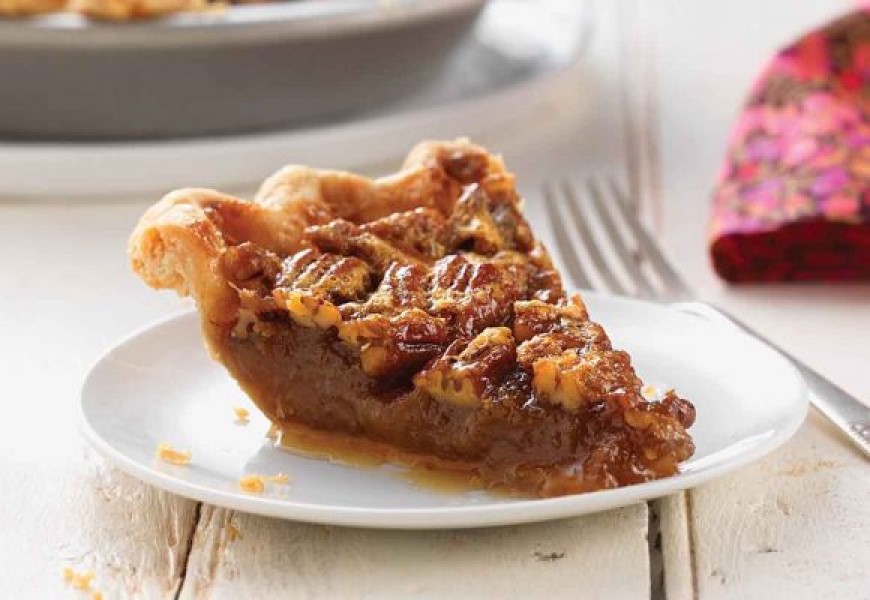Pecan Pie

By Farmers’ Market Institute, lover of food and all things local
You may prefer pecan pie with chocolate, or maybe bourbon. I am purist. Pecan pie is perfect on its own – the rich flavor of pecans, the caramel custard, the buttery crust. Today, I’m sharing a pecan pie recipe from Bon Appetit.
The first step to a great pecan pie is using great pecans. And, what a blessing that New Mexico grows some amazing pecans and that the Santa Fe Farmers’ Market has a pecan vendor, CLC Pecans. While halved pecans make for a gorgeous top, I prefer chopped nuts.
The next step to a great pecan pie is, of course, the crust. I am tempted to try this gluten free pecan crust recipe. More pecans? Yes, please! But, regardless of which pie crust recipe you use, don’t use a store-bought crust in those tin pans.Use a real pie plate – pyrex or ceramic. Chill the pie crust first, then add some foil and pie weights before you bake it for about 25 minutes. Then add the filling and bake some more.
The brown sugar is absolutely necessary because it adds to the dark, rich, full flavor of the filling. One difficulty with pecan pie is getting a filling with smooth consistency; it too easily gets grainy. That’s where the corn syrup comes in – it creates a smooth texture by preventing sugar crystallization during baking. Corn syrup is not the healthiest thing in the world, so people have adapted recipes by using maple syrup, honey, agave, brown rice syrup, golden syrup, molasses, cane syrup, etc. I think that as long as you avoid the high fructose corn syrup, you can eat this version without guilt. (Ok…maybe just a dash of guilt.) Also, consider cooling the sugar to about 200F before mixing it in with the eggs.
Another step towards the perfect pecan pie is to be willing to play around with your recipe. Does your filling somehow seep underneath the crust? Does it not firm up completely? Oven temps vary, so try slightly adjusting the temperature and the cook time. Try decreasing the butter a little and adding an egg yolk or two. If it is “weepy” then it may be overcooked or cooked too fast. Don’t rely on the recipe cook time; keep an eye on it. Some people take a more expensive (and tasty) route by filling the pie crust with chopped pecans before adding the filling, which makes it less gooey. You could also add cornstarch to your cold eggs before tempering in the sugar.
There are two things to look for when checking to see if your pie is done: puff and jiggle. It should be puffing up slightly from the edge to the center. Hold it by one edge and give it a little shake back and forth. If the filling is flowing in a wavy movement from the center to the edge, your pie isn’t set quite yet. It’s done if it has just a little jiggle.
The final step to achieving a great pecan pie is the most difficult step. The pie keeps cooking when you remove it from the oven, and it needs time to set. As difficult as it may be, you need to make sure the pie cools for 2-3 hours before serving.
What are your tips for a beautiful pecan pie? Share in the comments below.
The Recipe
Crust
Ingredients
- 1 tablespoon sugar
- 1½ teaspoons kosher salt
- 2 cups all-purpose flour, plus more for surface
- 5 tablespoons chilled unsalted butter, cut into pieces
- 3 tablespoons chilled lard or vegetable shortening
- 1 tablespoon apple cider vinegar
Filling
Ingredients
- 2 cups pecan halves
- 4 large eggs, room temperature, beaten to blend
- 1 cup light corn syrup
- ⅔ cup (packed) light brown sugar
- 1 tablespoon robust-flavored (dark) molasses
- 1 tablespoon vanilla extract
- 1 teaspoon kosher salt
- 6 tablespoons unsalted butter, melted, slightly cooled
PREPARATION
- Pulse sugar, salt, and 2 cups flour in a food processor until combined. Add butter and lard and pulse until mixture resembles coarse meal with a few pieces of butter and lard visible, about fifteen 1-second pulses. With motor running, drizzle in vinegar and 5½ Tbsp. ice water and pulse until dough is still crumbly but just holds together when squeezed (add 1 tsp. water at a time if necessary, but be careful not to overwork dough).
- Turn out dough onto a work surface. Knead 1–2 times, pressing just to incorporate any shaggy pieces. Flatten into a 6″-wide disk. Wrap with plastic wrap and chill at least 1 hour.
- Preheat oven to 425°. Roll out dough on a lightly floured work surface to a 14″ round. Transfer to a 9″ pie dish. Pick up edges and allow dough to slump down into dish, letting excess dough hang over dish. Trim, leaving about a 1″ overhang. Fold overhang under; pinch and crimp. Chill 30 minutes.
- Line dough with parchment paper or foil, leaving some overhang. Fill with pie weights or dried beans. Bake until crust is dry around the edges and just beginning to lightly brown, 25–35 minutes. Carefully remove parchment and weights and reduce oven temperature to 350°. Bake until crust is set and beginning to brown in the center, 10–15 minutes. Transfer to a wire rack and let cool.
- Keep the oven at 350°. Toast pecans on a rimmed baking sheet until browned and fragrant, 8–10 minutes. Let cool.
- Reduce oven temperature to 325°. Whisk eggs, corn syrup, brown sugar, molasses, vanilla, and salt in a large bowl until smooth. Slowly whisk in melted butter until combined. Fold in pecans and pour into cooled crust. This is a delicate process with many different technicques.
- Bake pie until edges are set and slightly puffed but center is recessed and wobbles like Jell-O, 55–70 minutes (it will continue to set after baking). Transfer to a wire rack and let cool at least 3 hours before slicing. Serve with ice cream.
Note
Dough can be made 3 days ahead; keep chilled, or freeze up to 2 months. Crust can be baked 1 day ahead; tightly wrap and store at room temperature. The pie can be baked 1 day ahead; tightly wrap and chill. Serve warm or at room temperature.
This locally inspired recipe is brought to you by Pam Walker. Pam is an avid home cook, writer, and local farm and food activist who is also a board member of the Santa Fe Farmers’ Market Institute. Thank you, Pam, for helping inspire us to use locally sourced ingredients!






